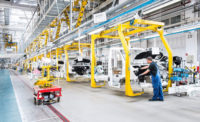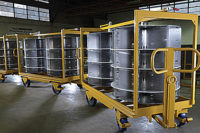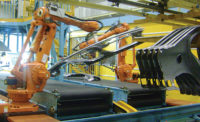If Ohio ever needs a catch phrase to promote its manufacturing success, “five out of eight is great” would be appropriate. The reason is because Ohio is home to five of Whirlpool Corp.’s eight U.S. assembly plants. Those five factories are located in the Ohio cities of Clyde, Findlay, Greenville, Marion and Ottawa.
Encompassing 2.4 million square feet, the Clyde plant is the largest washing machine factory in the world. More than 3,000 workers there produce 20,000 washers per day (over three shifts), five days a week. On average, one machine rolls down the line every four seconds.
A few years ago, plant management looked into ways to increase worker safety by lessening the use of forklifts. They purchased a vision-guided vehicle (VGV) made by Seegrid Corp. and had it move parts to workers along one assembly line. Since then, the company has installed more than 50 VGVs throughout the huge plant.
“For any manufacturer in the United States, there is an overall labor shortage, especially for skilled positions,” explains Jim Keppler, integrated supply chain vice president at Whirlpool. “The VGVs have let us move more than 150 people into value-added positions from those involving mundane work.”
Keppler says Whirlpool especially likes that the vehicles eliminate the problems of absenteeism and worker turnover, while improving worker safety and ensuring consistent delivery of parts to the line. In addition, the VGVs are easier to program than traditional automated guided vehicles (AGVs) that use lasers or follow wires, magnets or tapes on the floor.
“This evolution in AGVs lets us [easily] reconfigure the vehicles [for] new routes and assembly line locations within our facility,” notes Keppler. “It’s so easy that even a guy like me can do it. During one of my visits to the Clyde plant, the [managers] actually had me program one of the units.”
Seegrid offers an extensive line of VGV pallet trucks and tow tractors, all of which operate in automatic or manual mode for maximum flexibility. Tow tractors can be coupled with trailers, carts or dollies. Pallet trucks transport palletized goods.
Each vehicle is “trained” by an operator, who walks or drives the VGV along the desired route. During training, the vehicle captures images of the facility and builds a three-dimensional map of its surroundings. Once training is complete, the operator enters the desired route on the keypad and then loads the VGV with goods, either directly on the vehicle or onto carts or trailers.
The VGV then follows its three-dimensional map to safely and efficiently navigate through the facility and integrate flawlessly with the rest of the operation. When workflow and business needs change, any facility staff member can modify the VGV’s route.
Operators can use Seegrid Supervisor software for real-time monitoring and status updates, and to manage and control intersections. The software can also be integrated with external devices or existing software systems for VGV notifications, customized operation and dispatching for material transport.
Besides parts-to-line delivery, the vehicles can be used for long hauls, staging and sortation, replenishment, kitting and picking, trash removal and cross docking.
For more information on vision-guided vehicles, call 412-379-4500 or visit www.seegrid.com.





